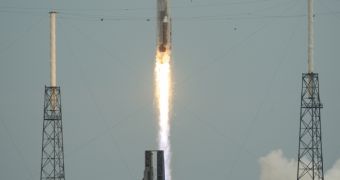The NASA Mars Atmosphere and Volatile Evolution (MAVEN) spacecraft was launched successfully yesterday, November 18, from the Cape Canaveral Air Force Station (CCAFS), in Florida. Take off occurred as planned, at 1:28 pm EST (1828 GMT).
The orbiter was delivered to low-Earth orbit by an Atlas V heavy-lift delivery system, and it is scheduled to achieve orbital insertion around the Red Planet on September 22, 2014. The mission took $641 million (475 million euros) to put together.
MAVEN separated from the Centaur upper stage of the Atlas V rocket about 53 minutes after launch. Some 7 minutes later, its solar panels unfurled successfully, and began powering the spacecraft. These panels will be its only power source over the 10-month journey to Mars.
The next month is critically important for the mission. Mission controllers plan to turn the vehicle on, and conduct rigorous assessments of all its systems, including the eight scientific instruments aboard.
Another series of checks will be conducted on the six deceleration thrusters that will slow MAVEN down right before it is captured by Mars' gravity pull. Any failure in these thrusters, and the spacecraft will either crash into our neighboring world, or zoom past at great speed.
By mid-October 2014, NASA officials want the orbiter up and running in Martian orbit. Officially, the primary scientific mission for this spacecraft will only last a year, but experts expect to be able to operate it for much longer.
For example, the NASA Mars Reconnaissance Orbiter has been orbiting Mars for nearly 8 years, though its initial mission concluded 5 years ago. In addition to the MRO and MAVEN, other missions around Mars include the European Space Agency's Mars Express and the NASA Mars Odyssey.
Augmenting these orbital assets are two NASA robots on the ground, the Mars Exploration Rover (MER) Opportunity and the Mars Science Laboratory (MSL) rover Curiosity. Another spacecraft is also on its way to Mars. The Mars Orbiter Mission (MOM) was launched by the Indian Space Research Organization (ISRO) less than two weeks ago.
“MAVEN joins our orbiters and rovers already at Mars to explore yet another facet of the Red Planet and prepare for human missions there by the 2030s,” comments NASA Administrator Charles Bolden.
“This mission is part of an integrated and strategic exploration program that is uncovering the mysteries of the solar system and enabling us to reach farther destinations,” he concluded.

 14 DAY TRIAL //
14 DAY TRIAL //